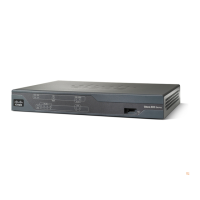Configuring Radio Settings on an Access Point
How to Configure Radio Settings on an Access Point
3
You can use the data rate settings to set up an AP to serve client devices operating at specific data rates.
For example, to set up the 2.4-GHz radio for 11 megabits per second (Mbps) service only, set the
11-Mbps rate to Basic and set the other data rates to Enabled. To set up the AP to serve only client
devices operating at 1 and 2 Mbps, set 1 and 2 to Basic and set the rest of the data rates to Enabled. To
set up the 5-GHz radio for 54 Mbps service only, set the 54-Mbps rate to Basic and set the other data
rates to Enabled.
You can also configure the AP to set the data rates automatically to optimize either range or throughput.
When you enter range for the data rate setting, the AP sets the 1 Mbps rate to basic and the other rates
to enabled. When you enter throughput for the data rate setting, the AP sets all four data rates to basic.
Universal Client Mode
Universal client mode is a wireless radio station role that allows the radio to act as a wireless client to
another access point or repeater. This feature is exclusive to the integrated radio running in the
Cisco 870, 1800, 2800, and 3800 integrated service routers (ISRs).
Universal client mode has the following features and limitations:
• You can configure universal client mode on the main dot11radio interface only, subinterfaces are
not supported.
• Universal client can associate to access points with radio VLANs.
• Layer-3 routing is supported over the radio interface. However, there is no support for layer 2 (L2)
bridging. The user cannot configure a dot11radio interface with a bridge-group when in universal
client mode.
• Service Set Identifiers (SSIDs) are required to be configured on the dot11 interface operating as a
universal client; association to an access point running in guest mode is not supported.
• The universal client can associate to Cisco access points, third party access points, and repeaters. It
cannot associate to Cisco root bridges or Cisco workgroup bridges.
• Easy VPN does not support universal client mode using DHCP.
How to Configure Radio Settings on an Access Point
This section contains the following tasks:
• Configuring Universal Client Mode, page 4 (optional)
• Configuring Radio Data Rates on an Access Point, page 5 (optional)
• Configuring Radio and Client Device Power Levels on an Access Point, page 6 (optional)
• Configuring Radio Channel Settings on an Access Point, page 8 (optional)
• Configuring Dynamic Frequency Selection on an Access Point, page 10 (optional)
• Enabling and Disabling World Mode on an Access Point, page 13 (optional)
• Enabling and Disabling Short Radio Preambles on an Access Point, page 15 (optional)
• Configuring Transmit and Receive Antennas on an Access Point, page 16 (optional)
• Enabling and Disabling Aironet Extensions on an Access Point, page 17 (optional)
• Configuring Ethernet Encapsulation Transformation Method on an Access Point, page 19 (optional)
• Configuring Beacon Period and DTIM on an Access Point, page 21 (optional)

